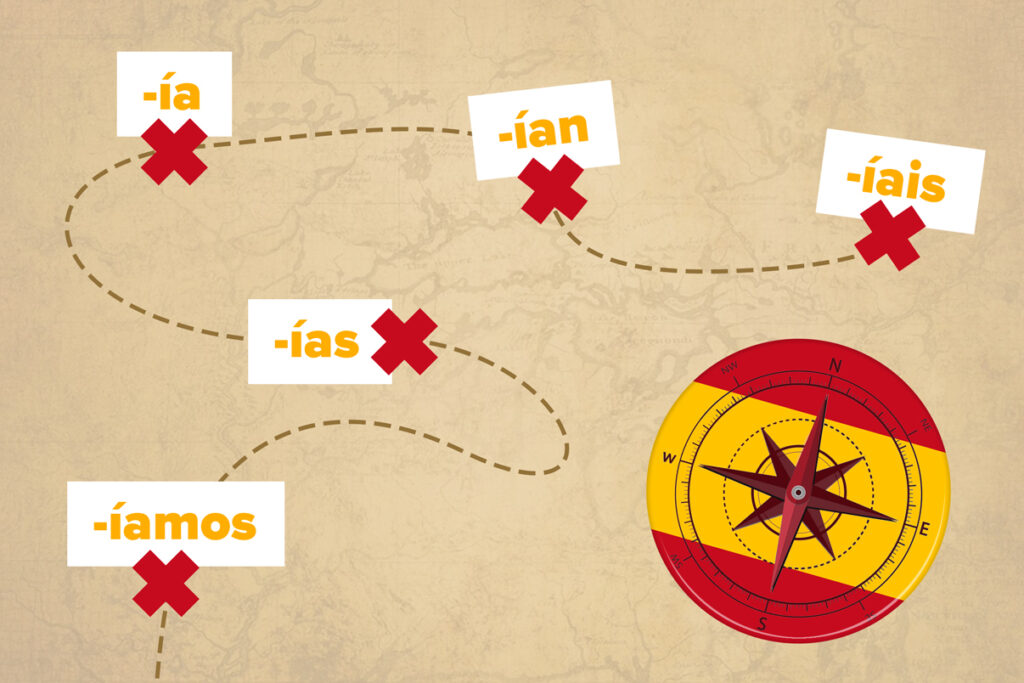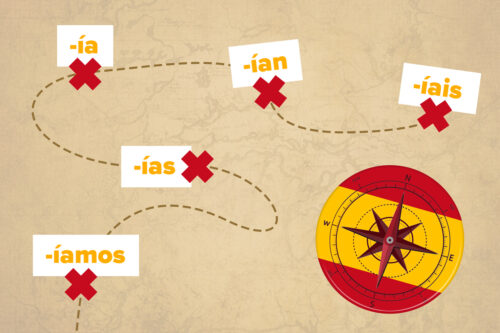
How much time do you spend talking about things that could have happened? Or things that could still happen in the future?
And how do we talk about them?
Whether it’s in English or Spanish, we use the conditional tense. In Spanish, it’s formed by adding the endings -ía, -ías, -ía, -íamos, -íais or -ían to the infinitive form of a verb.
This post will show you how to use the Spanish conditional and give you the confidence to talk about all possibilities!
Contents
Download:
This blog post is available as a convenient and portable PDF that you
can take anywhere.
Click here to get a copy. (Download)
What Is the Spanish Conditional Tense?
Spanish conditionals are used to talk about hypothetical things—things that could be, could have been or would have happened.
Think of the entire conditional tense as the English equivalent of “could’ve, should’ve, would’ve.” For example:
If I had a remote job, I would travel the world
You shouldn’t go out tonight
In Spanish, there are two conditional tenses, simple conditional and conditional perfect.
The simple conditional is what most people mean when they say the “conditional” tense. It typically applies to things that could happen now or in the future. For example:
Viajaría a Japón. (I would travel to Japan.)
¿Podrías ayudarme? (Could you help me?)
Then we have the conditional perfect, which is used to say “would have.” Here are some examples of the conditional perfect:
Habría llegado en Chile a las 8 si mi vuelo no retrasó. (I would have arrived in Chile at 8 if my flight wasn’t delayed.)
Ellos habrían venido con nosotros, pero su mamá no los permitió. (They would have come with us, but their mom wouldn’t let them.)
How To Conjugate the Spanish Conditional
There are just two things for you to bear in mind when conjugating the conditional tense: All three verb types (-ar, -er and -ir) have the same endings, and you just add the endings to the infinitive form of the verb.
All regular verbs in the simple conditional tense are conjugated like this:
| Pronoun | Conjugation | Example Using Comer |
|---|---|---|
| Yo | -ía | Comería |
| Tú | -ías | Comerías |
| Él/Ella/Usted | -ía | Comería |
| Nosotros | -íamos | Comeríamos |
| Vosotros | -íais | Comeríais |
| Ellos/Ellas/Ustedes | -ían | Comerían |
To form the conditional perfect, we use the formula:
Simple conditional of haber + past participle of the main verb
Here’s the irregular verb haber (to have) fully conjugated in the simple conditional:
| Subject Pronoun | Haber Conditional Conjugation |
|---|---|
| Yo | Habría |
| Tú | Habrías |
| Él/ella/usted | Habría |
| Nosotros/nosotras | Habríamos |
| Vosotros/vosotras | Habríais |
| Ellos/ellas/ustedes | Habrían |
Next, you’ll need the past participle. This is formed by taking the verb’s stem and adding -ado for -ar verbs and adding -ido for -er and -ir verbs.
Irregular verbs in the conditional tense
The list of irregular verbs is very short, and they’re verbs we use every day.
So the best solution is to learn their irregularities by heart.
It’s just the stem that slightly changes, so rather than using the infinitive, you’ll use the bolded stems listed below and add the same endings that you add to the regular verbs:
| Infinitive Verb | Conditional Stem |
|---|---|
| Salir (to leave/go out) | Saldr- |
| Tener (to have) | Tendr- |
| Valer (to cost/be worth) | Valdr- |
| Querer (to want/love) | Querr- |
| Decir (to say/tell) | Dir- |
| Hacer (to make/do) | Har- |
| Poner (to put/place) | Pondr- |
| Venir (to come) | Vendr- |
| Caber (to fit) | Cabr- |
| Haber (to have) | Habr- |
| Saber (to know) | Sabr- |
Uses of the Spanish Conditional Tense
1. To express the future in the past
Me dijo que se casaría conmigo.
(He told me he would marry me).
Le dije que eso me haría muy feliz.
(I told him that would make me very happy).
2. To speculate about the past
Se casarían a las 4 de la tarde.
(They must have gotten married at 4 p.m.)
Esa sería la razón por la que se enamoró de ella.
(That must have been the reason he fell in love with her.)
3. To make polite requests or suggestions
Me gustaría hacer un pedido.
(I’d like to place an order.)
Me encantaría pasar un fin de semana romántico en Barcelona.
(I would love to spend a romantic weekend in Barcelona.)
4. To make hypothetical statements
Me casaría contigo, pero antes debo ahorrar.
(I would marry you, but I have to save some money first.)
Viajaríamos a París, pero no podemos.
(We would travel to Paris but we can’t.)
5. To talk about events that might or might not occur
Sería romántico casarse en Madrid.
(It would be romantic to get married in Madrid.)
Ser tu esposa sería maravilloso.
(Being your wife would be wonderful.)
6. To ask for advice
¿Qué harías si te dejara?
(What would you do if he left you?)
¿Qué vestido comprarías para la boda?
(Which dress would you buy for the wedding?)
7. To talk about what would be done in a situation
¿Te casarías con él?
(Would you marry him?)
¿Le dirías la verdad sobre tu pasado?
(Would you tell him the truth about your past?)
8. To talk about things that probably won’t happen
We use the simple conditional along with the imperfect subjunctive to form the second conditional, which we will discuss later in this post.
Si me lo pidiera, me casaría con él.
(If he asked me, I would marry him.)
Si pudiera, le diría la verdad sobre mi pasado.
(If I could, I would tell him the truth about my past.)
As you can see, the simple conditional tense has many uses—perhaps even more than some other tenses! To get familiar with them, you need to use them with native speakers and consume natural Spanish content.
You can do this with an immersion program like FluentU, which lets you watch hundreds of authentic Spanish videos like movie trailers, news reports and inspiring talks. They all come with interactive subtitles, which makes it easier to learn about words you don’t know—and spot instances of the Spanish conditional in context.
9. To express the probability of a situation that has already happened
This situation calls for the conditional perfect tense.
Habría estado muy nervioso cuando le pidió matrimonio.
(He must have been very nervous when he asked her to marry him.)
Seguramente habrían perdido el avión a París.
(They had probably missed the plane to Paris.)
10. To talk about actions that would have happened but didn’t
This situation also uses the conditional perfect tense. In most cases, this use is directly related to the third conditional, which will be covered more later.
Si hubiéramos tenido dinero, nos habríamos casado el año pasado.
(If we had had money, we would have gotten married last year.)
Si no te hubiera querido, no me habría casado contigo.
(If I hadn’t loved you, I wouldn’t have married you).
The 4 Types of Spanish Conditionals
There are two clauses—or, parts—in a conditional sentence: the if clause and the main clause.
For example:
Si tuviera mucho tiempo, aprendería los verbos condicionales en español perfectamente.
(If I had a lot of time, I would learn Spanish conditionals perfectly.)
Four different types of conditional sentences are based on this structure—and note that we don’t actually need the conditional tense for all of these conditional types!
Si sabes el presente, sabes el condicional cero.
(If you know the present tense, you know the zero conditional.)
- First Conditional — Si + [present tense], [future tense]. Or [future tense] + si + [present tense]
The first conditional is used when discussing how something is possible or likely, assuming that a specific condition is met. Check out this post to brush up on your future tense.
Si llueve mañana, no iré al banco.
(If it rains tomorrow, I won’t go to the bank).
No iré al banco si llueve mañana.
(I won’t go to the bank if it rains tomorrow.)
Si tuviera la plata, iría contigo.
(If I had the money, I’d go with you).
- Third Conditional — Si + [past perfect subjunctive], [past perfect subjunctive]
The third conditional is used when you want to talk about a situation that did not happen in the past but has imaginary consequences. The past perfect subjunctive is also called the pluperfect subjunctive—and this post will jog your memory on how to use it.
Si hubiera sabido, te habría llamado.
(If I had known, I would have called you).
So that’s it! You’ve got everything that you need to use the conditional tense in Spanish.
With this skill, you’ll be talking about all hypotheticals, whether in the past, present, or future!
Download:
This blog post is available as a convenient and portable PDF that you
can take anywhere.
Click here to get a copy. (Download)



